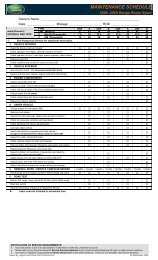THE BMW M3 COUPE AND CONVERTIBLE.
THE BMW M3 COUPE AND CONVERTIBLE.
THE BMW M3 COUPE AND CONVERTIBLE.
- No tags were found...
Create successful ePaper yourself
Turn your PDF publications into a flip-book with our unique Google optimized e-Paper software.
Chassis I Lightweight construction34 | 35The roof of the <strong>BMW</strong> <strong>M3</strong> Coupe is madeof carbon-fiber reinforced material,which is both light and very stiff.<strong>BMW</strong>’s use of lightweight construction:track control arms and dampers on the rearaxle are made from lightweight aluminum,as is the load-through. The rear bumpercarrier is made of a composite material,long-fiber thermoplastic. Perforatedcompound brake discs also contributetoward a reduction in weight.The front bumper carriers, which are made fromcomposite material, and the double-joint springstrutfront axle, constructed from aluminum, areas important to the overall lightweight conceptas the aluminum hood.A DRIVE THIS INSPIRING STARTSWITH A HIGH-PERFORMANCE PLATFORM.HIGHER PERFORMANCE STARTSAT <strong>THE</strong> TOP WITH LESS WEIGHT.When is a “sporty” vehicle considered truly“high performance”? When every componentworks together seamlessly. That’s where the<strong>M3</strong> shines. At the heart of the <strong>M3</strong>’s responsivehandling lies a front axle made primarily ofaluminum, including the central subframe,the spring struts, the swivel bearings, and anadditional thrust plate across the entire framefor added stability. As a result, the front axleis not only lightweight, it’s extremely rigid.Redesigned from the ground up – except for asingle trailing link borrowed from the 3 Seriesplatform – the five-arm rear axle features allaluminumtrack control arms, as well asaluminum dampers. And when compared toconstruction using more conventional materials,the rear axle is stiffer and 5.5 lbs. lighter.Optimized for weight and stability, anti-rollbars are featured in both the front and rearof the <strong>M3</strong>’s chassis. Once again, specialengineering of the axle geometry (whichfeatures two additional longitudinal bars)contributes to the <strong>M3</strong>’s powerful, sportydynamics and road feel.Working in conjunction with the suspension,the <strong>M3</strong>’s final drive features a Variable MDifferential Lock, which provides up to 100 %locking action for optimal traction on anysurface, in any conditions.The suspension design allows the rest of thevehicle’s innovative, performance-enhancingfeatures – from the heavy-duty manual transmissionto the <strong>M3</strong> Coupe’s carbon-fiber roof– to operate at their most thrilling capacity. It’sthe solid foundation that plays a huge role inthe <strong>M3</strong>’s unmatched driving dynamics.The <strong>M3</strong> benefits from lightweight construction– in its suspension, its perforated compoundbrake discs, aluminum hood, and even itscomposite front fenders. But just reducingweight isn’t enough to optimize a vehicle’sdriving dynamics. That’s why <strong>BMW</strong> reducedweight in areas where it would have a positiveeffect on driving characteristics. M-style agilityis achieved by concentrating the vehicle’sweight as close as possible to its center ofgravity. Accordingly, <strong>BMW</strong> used carbon-fiberreinforced material – a particularly light andextremely rigid high-tech composite – in theroof of the <strong>M3</strong> Coupe, to lower the vehicle’scenter of gravity. And when combined withthe <strong>M3</strong>’s near-perfect 50/50 balance front andrear, the advantages of lighter weight and alower center of gravity become obvious inthe <strong>M3</strong>’s powerful drive, high-revving pickup,improved roadholding and shorter brakingdistances.








